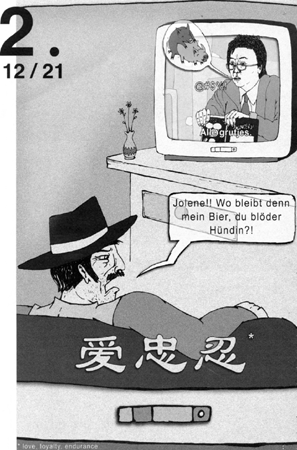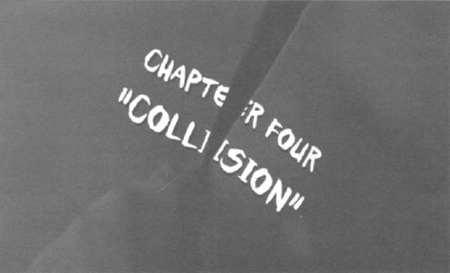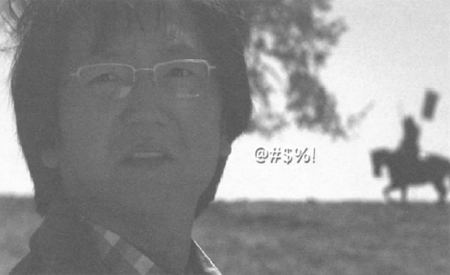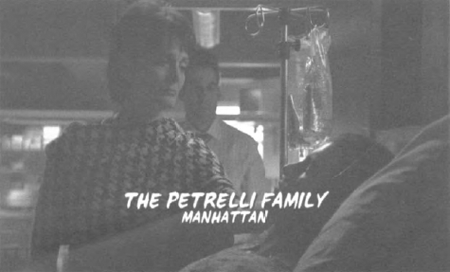Vooys. Jaargang 26
(2008)– [tijdschrift] Vooys–
[pagina 12]
| ||||||||||
2. 12/21  | ||||||||||
[pagina 13]
| ||||||||||
Inventing otherness
| ||||||||||
[pagina 14]
| ||||||||||
through abusive subtitling. To investigate this seeming paradox, we will look at another recent example: the television series heroes (Tim Kring, 2006-present). The show's globe-spanning ensemble cast includes fan-favourite Japanese characters Hiro and his friend Ando, as well as (from the second season) the Mexican girl Maya and her brother Alejandro. The term ‘subtitling’ is not entirely adequate for the way the translations of Hiro and Ando's conversations are displayed, as the titles are rarely at the bottom of the screen. Instead, the characters' translated words are placed in varying locations across the screen, although, as will be shown, they are not random. Maya and Alejandro, on the other hand, are subtitled in a more traditional manner, with text placed at the bottom of the screen. However, their text appears in yellow lettering instead of the standard white used for Hiro and Ando. As we shall see, these differences play an important part in explaining the presence of these seemingly disruptive elements in such a mainstream environment. | ||||||||||
InvisibilityOf all the ways in which image and word can overlap, collide, and mingle, the subtitle should surely be the most visible. Subtitles are words placed within an image; they thus come to stand between the image and the viewer; and they can sometimes become images themselves. Moreover, translation plays a central role in film and television viewing practices in most countries of the world; here one could refer to the oft-cited (but rarely substantiated) claim that the average Dutch person's reading habits are mostly comprised of subtitles. Watching films in their ‘original’, untranslated form is not the norm, but a relative rarity. Yet despite its centrality, subtitling has been largely ignored by critics of the media, both in theory and in practice (as has the other central technology of screen translation, dubbing - both subtitling's partner in crime and its adversary). Every so often one can find a light-hearted discussion of the ‘subtitling versus dubbing’ debate in the Dutch press, which usually starts with a slightly ludicrous example of dubbing. More often than not this is an American cowboy dubbed by those wacky Germans: ‘OK Johnny, gehen wir in den Saloon’. (Van Bracht 1998) Academic circles are not much better; in fact, it is only a slight exaggeration to say that the lack of academic attention has over the years received more attention than audiovisual translation itself. There have been a number of insightful publications on the subject, starting from the moment when silent film became sound film in the late 1920s. The field has also seen progress (both in an increasing number of publications and in the depth of their theoretical insights) in the wake of the strong developments in the field of translation studies in the late 1970s and early 1980s. But substantial and systematic research into audiovisual translation has only started to emerge since the late 1990s, and a central discourse is still lacking. This lack of academic attention has often been explained by the translation techniques' own attempts at invisibility. Both subtitlers and dubbers consciously strive towards a translation that is not recognizable as such: subtitles should be as unnoticeable as possible. (Bruls & Kerkman 1988: 90) Donald Richie's account of his subtitling work on Akira Kurosawa's ran (1985) makes this explicit: ‘Any oddity, any term too heightened, as well as any mistake, calls attention to this written dialogue. I won't even | ||||||||||
[pagina 15]
| ||||||||||
use exclamation points. The language should enter the ear as the image enters the eye.’ (Richie 1991: 16) Subtitlers generally succeed so well in their quest for invisibility that not even academics studying specific films in translated prints (for instance because the ‘original’ was lost, as is often the case in early cinema) seem to notice the fact of translation; at least they seldom make reference to it. But this logic could also be reversed: one might say that audiovisual translation's tendency towards invisibility has persisted only because there was no academic countermovement. An approach to translation wherein the translation makes itself visible and questions itself can only be born from a theoretical questioning of translation itself. Where there is no theory, there can be no visibility. Indeed, it is precisely this attempt at invisibility, this ‘method of translation that conspires to hide its work - along with its ideological assumptions’, that Nornes deems corrupt: ‘It is a practice of translation that smoothes over its textual violence and domesticates all otherness while it pretends to bring the audience to an experience of the foreign.’ (Nornes 1999: 18) As Nornes himself implies, the difference between ‘corrupt’ and ‘abusive’ subtitling is closely related to ‘the two basic patterns first outlined by Cicero 2.000 years ago: [...] a sense-for-sense hermeneutic search for, and transmission of, meaning, and a word-for word translation of language's material qualities.’ (Nornes 1999: 25) Nornes, primarily drawing his examples from the Japanese film industry, divides the history of cinematic translation into three epochs. After the first era, that of the first sound films in which translations fluctuated between the two extremes, and the second era, the epoch of corrupt sense-for-sense subtitling spanning from the 1940s to the present, he believes now is the time for the Abusive Turn. In the epoch of abusive subtitling the emphasis is on word-for-word translation - although ‘[a]busive translations are also sense-for-sense translations to varying degrees, as a truly word-for-word substitution [...] would result in meaningless gibberish.’ (Nornes 1999: 29) The central point for Nornes is that subtitles should not hide their foreign origins, but instead should highlight the fact of translation, thereby bringing the viewer to the ‘otherness’ of the foreign text. He argues for a translation that ‘does not present a foreign divested of its otherness, but strives to translate from and within the place of the other by an inventive approach to language use and the steady refusal of rules.’ (Nornes 1999: 29) | ||||||||||
Abusive subtitlingThis refusal of rules makes it difficult to pinpoint what Nornes means exactly when he speaks of abusive subtitling. He does, however, give several examples of what it may entail. He refers, for instance, to Donald Richie's subtitles for ran, as mentioned before. Richie chose to translate the specialised language of the samurai film into the stilted constructions of formal court English. Richie later denounced his experiment, calling it ‘not incorrect but, in dialogue titles, completely inappropriate.’ (Richie 1991: 16) Nornes, on the other hand, celebrates the experimental subtitles ‘for the way they approximated the generically tortured Japanese of the film itself’. (Nornes 1999: 30) But the most ‘daring and thrilling of the emerging abusive subtitle’ are to be found in places ‘where capital does not enforce the rules and regulations of corruption.’ | ||||||||||
[pagina 16]
| ||||||||||
(Nornes 1999: 31) Primarily, Nornes refers here to so-called fansubs: ‘fan-produced, translated, subtitled version of a Japanese anime programme.’ (Díaz Cintas & Muñoz Sánchez 2006: 37) Nornes' explanation of the modes of translation these fansubs employ, is a succinct distillation of what abusive subtitling amounts to: Working outside of the mainstream translation industry, lacking any formal training, these fans have produced abusive subtitles quite by instinct. In scenes with overlapping dialogue, they used different colored subtitles. Confronted with untranslatable words, they introduce the foreign word into the English language with a definition that sometimes fills the screen. [...] They use different fonts, sizes and colors to correspond to material aspects of language, from voice to dialect to written text within the frame. And they freely insert their ‘subtitles’ all over the screen. (Nornes 1999: 31-2, emphasis in original) As we shall see, many of these same techniques are used in the translations for heroes. Before we look more closely at this, however, it is important to note that we are analyzing the show as it is broadcast in America, and as it is available internationally on DVD. Broadcast versions in non-English speaking territories, including the Netherlands, generally nullify the abusive subtitling strategies as they are absorbed into the general translation practice of the respective countries. Thus when the first season of heroes was broadcast by RTL5 in the Netherlands, the oddly placed titles for Hiro and Ando were removed and replaced with the standard subtitles used for all characters. The same is true for nochnoi dozor: the animated titles were only applied for the British and American theatrical releases. In most other non-Russian speaking territories, the film was translated through the respective standard practices of those territories. Thus the Dutch release had ‘regular’ subtitles, much to the chagrin of many fantasy cinema fans - as well as film critic Dana Linssen: [...] vistors of the Amsterdam Fantastic Film Festival, which was opened with nochnoi dozor in June, saw the subtitles evaporate, dissolve into smoke, and glisten in puddles. The version with Dutch subtitles unfortunately abandons this inventive Spielerei. (Linssen 2005) In the case of nochnoi dozor, it is likely that the subtitles were not animated partly due to the cost: the process is significantly more expensive than regular subtitles. This cost was acceptable for the U.K. and U.S. since the inventive titles could become part of the film's marketing - implying the film's ‘otherness’ by the fact that it could not be subtitled using the regular techniques. Another reason, related to the first, may be that only a few non-English spoken films are released in both the U.K. and the U.S., thus making subtitles such a rarity that the animated titles were not such a departure from the norm. That is, subtitles themselves were enough of a departure that the leap to animated subtitles was not that great. In the Netherlands, on the other hand, foreign films make up approximately 90% of the cinema releases, which has resulted in a completely standardized translation practice. In this context it will likely be much harder to | ||||||||||
[pagina 17]
| ||||||||||
 Image 1: Semi-diegetic titles (from episode 1x04, ‘Collision’, original U.S. airdate: October 16, 2006).
implement Nornes' abusive subtitling, since it would require a departure from the highly conventionalized translation apparatus that is in place. | ||||||||||
@#$%!As was stated above, several of the techniques Nornes highlights as abusive are used as translation strategies in heroes. The show, created by Tim Kring and broadcast by NBC from 2006, centres on a group of ordinary people who suddenly and mysteriously develop superhuman powers: some can fly, some are invincible, and others can paint the future. The drama of the show unfolds through the inquiries of the world-wide ensemble cast into the origins of these powers, and their use in preventing several large-scale catastrophes. As even this short synopsis makes clear, the show heavily refers to the world of American superhero comic-books (although no capes, masks or utility belts have appeared in the series to date). Indeed, several venerable comicbook writers (i.e. Jeff Loeb) and artists (i.e. Tim Sale) work on heroes. This relation to the comicbook form shows in the series' approach to on-screen text as well, with the titles that appear at the start of every episode, which float somewhere between the diegesis and the screen. For the viewer, they are part of the show's environment, but they are not visible to the characters. (Image 1) These titles can be seen as a direct reference to the title pages of comicbooks, where characters seemingly interact with title designs that nevertheless are obviously not part of the comicbook world. A similar link to comicbook design can be made regarding the use of subtitles. While the show is fond of implying its global scope, the only characters who do not speak English in the first season are Hiro and Ando. The diminutive Hiro, an office drone for his father's Japanese company, finds he can bend space and time, giving him the power to teleport and freeze time. Primarily used as a comedic character, Hiro's wide-eyed sense of wonder and his enthusiasm for his newfound powers (as played by Masi Oka) quickly made the character a fan-favourite, leading to a more dramatic (but less well-received) storyline in the second season (which was shortened due to the writers' | ||||||||||
[pagina 18]
| ||||||||||
 Image 2: Hiro in the 17th Century (from episode 1x23, ‘How to Stop an Exploding Man’, original U.S. airdate: May 21, 2007).
strike in early 2008). Hiro speaks only a handful of words in English, and for much of the first season his friend Ando functions as his translator after they teleport from Japan to America. But their private conversations, as well as Hiro's discussions with his father Kaito Nakamura (played by George Takei) in the second half of the season, are carried out in Japanese. These conversations are translated in white text in a standard, nondescript font. The interesting, and possibly abusive, aspect is their location on the screen: the words do not appear at their standard location at the bottom of the screen, but are put in varying places. The exact placement seems to be dependent on aspects such as the composition of the frame and the location of the speaker within it. Here we can again draw a direct relation to comicbooks; while the subtitles are not enclosed in word balloons, their placement within the frame functions in a similar way. The comicbook-ness of Hiro's subtitles becomes even more pronounced in the final scene of the final episode of the first season, in which Hiro somehow accidentally teleports to 17th Century Japan... right in front of a charging horde of horseback samurai. Hiro's startled expression is translated as @#$%!, implying but not actually showing a swearword. (Image 2) The joke actually becomes double-edged for those who do speak Japanese, as Hiro's statement ‘dai pinchi’ (literally ‘big pinch’ - as in, ‘I'm in a pinch’) is by no means offensive.Ga naar voetnoot1 Thus, the creators have their cake and eat it too: the ‘censored’ English translation implies a swearword that is not actually there in Japanese, but the mild Japanese term also becomes coloured as offensive by displaying its ‘censored’ English translation. This visual joke is a clear reference to comicbook swearing, but funnily enough also surfaces in Nornes' article. The translation of swearwords is one of the eternal questions of the audiovisual translators, who are often accused of censorship as they usually use much milder terms in the translations, or even ‘neglect’ to translate swear words at all. While this is indeed partly to do with censorship, the practice is also widespread in | ||||||||||
[pagina 19]
| ||||||||||
countries where there is no strict censorship, such as the Netherlands. Here, translators defend their choice by claiming that offensive terms leave a much stronger impression in written form than their spoken counterparts. For Nornes, this practice is part of corrupt subtitling's yearning for invisibility. He therefore applauds Rob Young's use of comicbook-style swearwords in translating tenamonya connection (Masashi Yamamoto, 1990), as it highlights ‘the translator's attempt to experiment with language in ways that are analogous to the linguistic playfulness of the original scenario and its verbalisation.’ (Nornes 1999: 30) | ||||||||||
Cultural connotationThe stylistic placement of text as it is used in comicbooks is a valid reference for ‘Japanese’ subtitles used in heroes. But there is another connection that, while more obscure, is of stronger importance to the argument in this article. This connection becomes more clear at the start of the second season, when several new characters are added to the cast. Among them are Mexican twin sister and brother Maya and Alejandro. Their powers cancel each other out: when Maya cries, her black tears kill everyone around her; Alejandro's gift is the ability to reverse her actions. Believing that a cure for their conditions can be found in America, they attempt to enter the country illegally from their native Mexico. Unlike the Japanese conversations of Hiro and Ando, Maya and Alejandro's Spanish words are translated in a more traditional way, with text placed in two lines at the bottom of the screen. They use (roughly) the same nondescript font as the titles used for the translations of the Japanese dialogue. But the ‘Mexican’ subtitles set themselves apart in an important way: they are yellow instead of the standard white. This seemingly random aesthetic choice has important connotations that put the ‘Japanese’ subtitles in a different light as well. While European audiences may be used to white subtitles, yellow is the standard choice, or at least a strong alternative, in many other parts of the world, most notably many parts of Latin America. Furthermore, Spanish-language closed captioningGa naar voetnoot2 on American broadcast television is often provided in yellow. Thus, the aesthetics of the ‘Mexican’ subtitles are linked to a certain cultural heritage connotating ‘Mexicanness’. If we look at the ‘Japanese’ titles again in this light, it becomes clear that they, too, refer back to a cultural aspect: the Japanese (or more generally Asian) mode of (sub) titling in which text is placed freely across the screen. This cultural connotation is central in explaining the presence of these seemingly disruptive textual/visual elements in a mainstream series. heroes' sprawling narrative and multitude of characters requires viewers to pay attention in order to keep up. The creators help them along in various ways. Firstly, most scenes have a tagline identifying its location and main characters - another usage of text on screen in the series. (Image 3.) Also, while the show is filmed entirely in Los Angeles, its scenes take place in a great many locations around the world, from Tokyo, Japan to Madras, India. The key locations are set apart by distinct uses of | ||||||||||
[pagina 20]
| ||||||||||
 Image 3: Location information (from episode 1×12 ‘Godsend’, original U.S. airdate: January 22, 2007).
colour: New York has a cold, blue look whereas the Texan desert is a yellowish brown and the Mexican scenes mostly play in shades of green and brown. As production designer Ruth Amonn explains in the behind the scenes programme heroes unmasked (episode 1×14 ‘Sets and the City’), these distinct characterisations of different locations serve to guide the viewer as to where in the show's world they are at each moment. The subtitles serve a similar function: they immediately make clear to any viewer entering the scene halfway through in which environment it takes place, and thus what is at stake. Instead of the abusive potential that Nornes inscribes them with, these seemingly disruptive techniques are applied to further narrative clarity - and in so doing make themselves invisible. It is tempting to think of Jay Bolter and Richard Grusin's dual logic of remediation: by highlighting their varying forms (hypermediacy) the subtitles become all the more invisible (immediacy). The disruptive techniques are diverted, in ‘Classical Hollywood Style’, and used for corrupting ends. | ||||||||||
SimulacraIn his 2007 book, Nornes warns that abusive subtitling should not be ‘unfairly reduced to graphic play and little else’ (Nornes 2007: 224), yet what ‘else’ it is, or should be, remains rather vague in his theory and his examples. Answering the question how heroes can so easily sidestep the abusive potential of these highly visible techniques - in other words, looking at what makes them not abusive - may bring us closer to this. Returning to Nornes' original article, his notion of abusive subtitling has as its central concern the viewer's relationship to the foreign original. Instead of domesticating the foreign text, translators should bring the reader to it: ‘abusive subtitling avoids this kind of erasure of difference, seeking to intensify the interaction between the reader and the foreign.’ (Nornes 1999: 29) But in heroes there is no foreign original. Or rather, there is something foreign, but it is not the original. While there are undoubtedly people with knowledge of Japanese and Spanish in the production team, it would be illogical for all the writers on the show | ||||||||||
[pagina 21]
| ||||||||||
to know both languages. Thus, we should assume that scripts are written in English and then translated for purposes of dialogue. In other words: the subtitles as we read them are the original text, and the spoken Japanese or Mexican words are the translations. Because of this, the subtitlers have none of the problems usually associated with audiovisual translations - most notably the necessity for abbreviation of the text by up to 40%. Thus, while the subtitling in heroes has all the surface characteristics of abusive subtitling, it does not deal with any of the underlying ideological dimensions. Nornes propagates translations which retain as much as is possible of the foreign, bringing the viewer to it. But instead of bringing the viewer to a foreign text, these subtitles in heroes imply a foreign ‘other’ that is simply not there. With an ear for hyperbole and provocation, one could say that they constitute Baudrillardian simulacra of otherness. They give a mediated shorthand for ‘foreign’, without providing any substance. For a theorist as invested in ‘the other’ as Nornes, this emptiness at the heart of heroes' subtitles probably feels like the ultimate corruption of his abusive ideals. | ||||||||||
References
|
|

